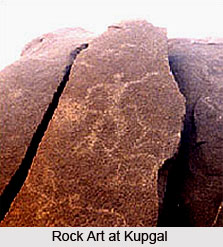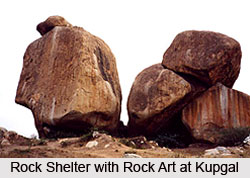 Rock art of Kupgal dates back to Neolithic and Old Stone Age and form significant archaeological subjects. Thousands of them have been discovered at Kupgal village situated in Bellary district of Karnataka. The place is also known for peculiar rock formations having unusual depressions. These stones when stuck with boulders produce musical sounds. The rock arts have been observed on the slopes and atop granite hills. The most intriguing site for archaeological researches have been found in the northernmost part of the granite hill which was referred as `Peacock Hill` during the colonial rule of the British. Local folks call them as Hiregudda which means `Big Hills` in Kannada language. Archaeological researches mostly refer them as Kupgal hill owing to its location near the village of the same name. It has been established that the place was inhabited by the people belonging to Neolithic age about 4000 to 3300 years ago. The hill is quite large, has several peaks and along its axis there is a large dolerite trap dyke.
Rock art of Kupgal dates back to Neolithic and Old Stone Age and form significant archaeological subjects. Thousands of them have been discovered at Kupgal village situated in Bellary district of Karnataka. The place is also known for peculiar rock formations having unusual depressions. These stones when stuck with boulders produce musical sounds. The rock arts have been observed on the slopes and atop granite hills. The most intriguing site for archaeological researches have been found in the northernmost part of the granite hill which was referred as `Peacock Hill` during the colonial rule of the British. Local folks call them as Hiregudda which means `Big Hills` in Kannada language. Archaeological researches mostly refer them as Kupgal hill owing to its location near the village of the same name. It has been established that the place was inhabited by the people belonging to Neolithic age about 4000 to 3300 years ago. The hill is quite large, has several peaks and along its axis there is a large dolerite trap dyke.
Rock arts at Kupgal hill belong to different eras starting from Neolithic to modern day. The black rocks all along the dyke can be witnessed as engraved or bruised. The place where the dyke emerges out from the upper northern peak, high concentration of rock art can be found. The site was previously mentioned in a number of publications along with their pictures form 19th century but it remained lost as the original pictures faded out or got lost with time. In the year 2002, study of the site was once again carried out by Dr. Boivin in association with Ravi Korisettar of the Karnataka University after which the photographs of the rock art of Kupgal was published for the second time.

Apart form the proto-Harappan Neolithic age discovered there, certain south Indian Neolithic were also found at the site which overlapped with the phase of mature Harappan civilization. Exact dating of these artefacts of South Indian Neolithic has been quite difficult so far, however a rough chronological sequence have been provided to them on the basis of their artistic styles, content of rock art, methodology and resemblance to the archaeological sites of the of known eras. Their weathering characteristics and association of their features with other sites of Neolithic period also play an important role in their identification.
On the rocks of Kupgal, several motifs of cattle especially with long horn and humped back have been found. Some human like figures either alone or accompanied with cattle are also prominent. Some of these figures are in chain form or along with bows and arrows. Most of the engravings found are masculine in nature which suggests that the people involved in these rock arts were men engaged in herding cattle. Stone implements were used in bruising the rocks for making the motifs. Some of the rock arts are so inaccessible that it suggests that the artists probably had suspended themselves to an overhang for making the images. Some rocks have peculiar depressions which are often referred as musical rocks as they produce musical tones when struck with boulders. It has been inferred that these were used as percussion instruments for certain rituals.



















